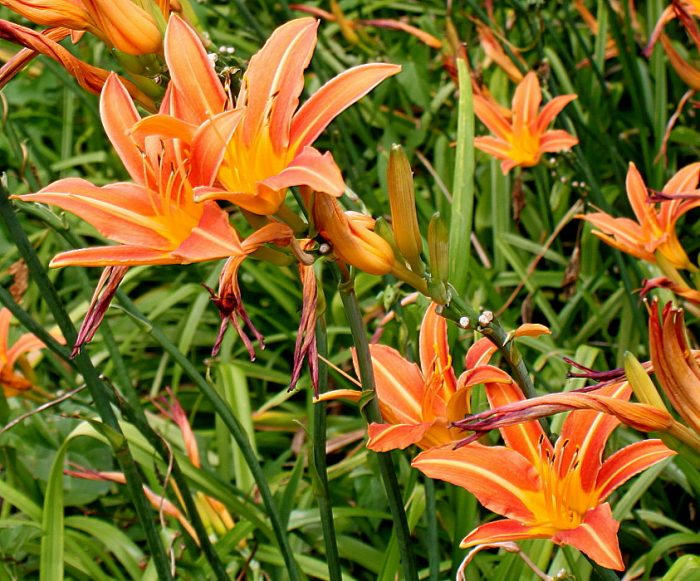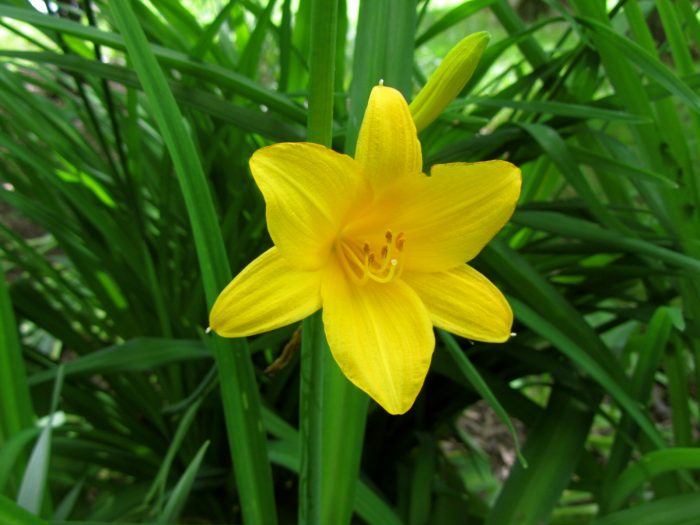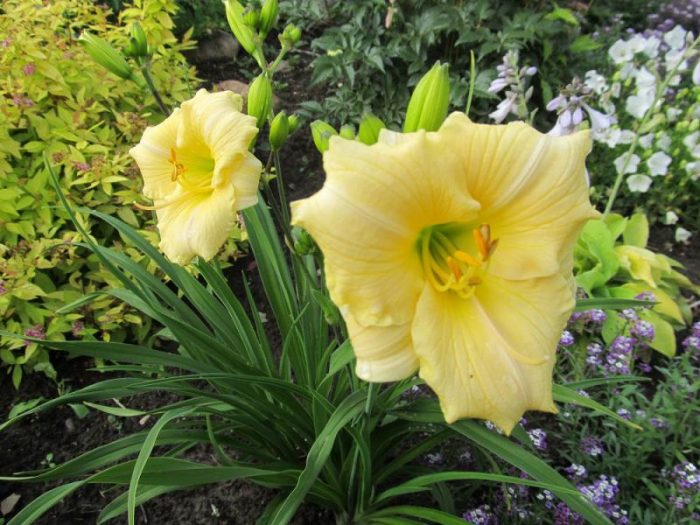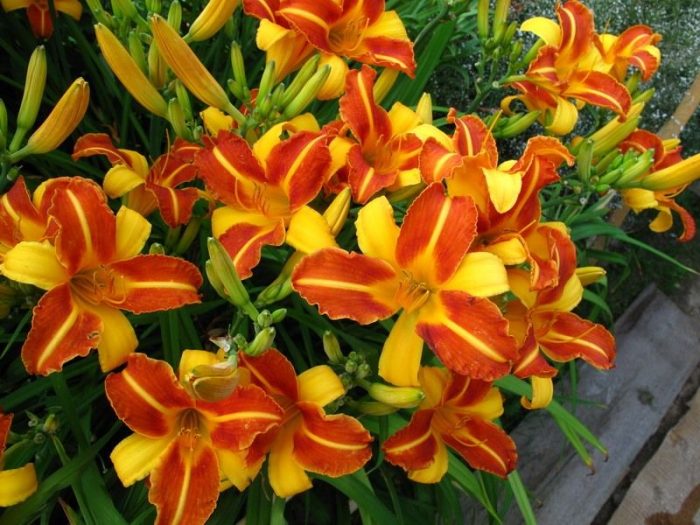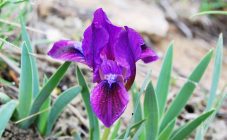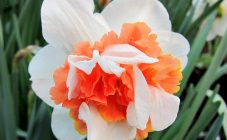Daylilies are very beautiful flowers, distinguished by lush flowering, voluminous growth, a variety of varieties and colors. Today, there are tens of thousands of all kinds of daylily. As for a brief description of the culture, these plants have large flowers that illuminate the garden with almost all the colors of the rainbow and their most diverse variants (yellow, reddish, purple, etc.). Such numerous forms and varietal varieties of crops have resulted from laborious selection work, which also includes the hybridization of individual plant species.
Types and popular varieties of daylily
The most famous and widespread species of this culture are the following:
- The daylily is brown-yellow. It is characterized by deep green pointed leaves. Able to actively grow and develop both in illuminated areas and in shaded areas. Forms dense thickets, over which the flowers, crowning tall peduncles, "burn" brightly with orange fire.
- Daylily is yellow. Despite the similarity with the previous one, in this case the leaves fall more downward as they grow. Corolla diameter is about 10 cm. Flowers are painted in a bright "sunny" color.
- Daylily lemon yellow. The height of the shoots reaches 120 cm, on their tops are pale yellow or light green flowers.
The first varieties of daylilies were obtained by crossing various species of this plant. In addition to the phenotypic traits of parental cultures, the created forms acquired such properties as:
- longer flowering;
- large flowers with double corollas;
- less dependence on external factors of influence in the place of growth.
Due to the wide variety of colors, shapes and other traits, many modern hybrids have been classified into groups according to several criteria.
In particular, plants are divided into groups depending on the shape of the flower:
- simple;
- terry (petals are folded in several rows);
- arachnids (petals strongly elongated in length);
- indefinite form;
- combinations of different shapes.
The daylily bud lives for a day. Thus, according to the type of flowering, the following varieties are distinguished:
- daytime;
- night;
- long flowering.
Depending on the size of the plant, as well as their buds, miniature forms are distinguished, the height of which is no more than 30-40 cm, and gigantic, since their peduncles grow up to 1.5 m.The first ones have small corollas, reaching 7-8 cm in diameter In the latter, they are quite large and grow up to 15-17 cm.
Among the most popular daylily varieties are the following:
- Daylily Bonanza... The yellow corolla has a red coating. The plant of this variety easily tolerates a lack of water, loves sunlight and does not require complex maintenance. It blooms in mid-July, has a frost resistance and a low susceptibility to diseases and pests. If the crop is grown in partial shade, the flowering will not be as intense, but the foliage will begin to develop intensively from the very beginning of spring and will retain its color until the onset of autumn frosts.
- Daylily Longfields Pearl... Corollas of this variety are very similar to lilies, so it is easy to confuse them.The color of flowers for both is yellowish with an admixture of cream tones. The petals form a conical shape, wide in diameter (10 cm). The core has a yellow-green hue, then the range turns into creamy-creamy tones. Leaves are narrow, pointed, rich green. The flower of this variety is unpretentious in terms of care and cultivation. Longfields should be regularly watered and cleaned from weeds and debris under the leaves. In order for the plant to always remain as beautiful, in the summer, wilted buds are removed from the shoots. You also need to transplant the daylily once every 5-6 years.
- Daylily Frans Hals... The height of the stems reaches 1 m, the diameter of the flowers, sitting on high (up to 1 m) stems, can reach 15 cm. The plant is distinguished by a light orange color of the buds. Thanks to breeding work, it was possible to combine two colors: the petals are painted in yellow and orange tones, while the latter are combined with a bright yellow median vein. Thus, the variety has unique decorative qualities, representing an excellent decoration for a city flower bed, any garden or suburban area.
- Daylily Katherine Woodbury... A distinctive feature of this variety is a surprisingly beautiful, soft dark purple shade of petals, which stand out noticeably against the background of a light green neck. The diameter of the flowers varies from 12 to 16 cm. The flowering time falls in the second half of the summer season. It is noteworthy that in the sun the petals acquire a yellowish-pink hue, and in the shade they turn purple.
- Daylily Night Bacon... The flowers of this plant combine contrasting colors: rich purple and yellow. The diameter of the buds reaches 8 cm. The foliage, like most other varieties, drops downward, and the flowers, rising above the rosette, stand out brightly against its background and do not fade in the sun. The plant feels great both in well-lit areas and in partial shade, where the flowers are framed in thick purple velvet.
- Daylily Stella de Oro... This variety is one of the miniature daylilies: the height of the culture is approximately 30-40 cm. The yellow flowers are star-shaped. The corolla of the same shade reaches 6-7 cm in diameter. The variety grows very compactly and is characterized by long, lush flowering, which occurs in waves throughout the summer season. The culture is ideal for growing in garden and suburban areas.
- Daylily Bestseller... It has a number of advantages. Firstly, the culture has large (up to 14 cm in diameter) flowers. Secondly, lush greenery 60-70 cm high will give any garden a wonderful decorative look. Thirdly, it has an exquisite pink-lilac color of the corolla, which is distinguished by an unusual refined shape. The petals are dazzled with a fancy border, painted in green and yellow tones. Flowering time is from June to August.
- Daylily Divas Chois... The flowers resemble the buds of a garden lily. The main similarity lies in the beige-pink color of the petals. The lemon-yellow core of the neck smoothly flows into yellow, then pink and coral tones. A pleated frill runs along the edges of the petals. The diameter of a blossoming flower can reach 17 cm. It is noteworthy that several (3-4) buds can be on one shoot at once.
- Daylily Pandoras Boxing... For the first time this variety became known to the world in 1980.Since then, the culture has never ceased to amaze with unusual combinations of all sorts of tones, compact bush shape and stable flowering. The height of the shoots is about 50 cm. The plant is distinguished by abundant and long flowering. Inside the cherry center, surrounded by creamy petals, is a light green neck.
- Day lily Sorry Mi. It is also a miniature hybrid with lush greenery 40-50 cm high. The culture annually rejoices in the abundant flowering of densely cherry buds with a lemon-yellow neck. Such a contrasting combination of tones is the main feature and advantage of this culture. The flowering period is from July to September.Well, the plant needs to be transplanted often, it is unpretentious in care and goes well with other varieties of the same group of miniature daylilies.
- Daylily Double River Wye... This variety belongs to double daylilies, has yellow petals. The culture blooms in the daytime. The rich colors of dense greenery delight those around from the beginning of the first days of May until the very late autumn. From the moment the bud opens and until its wilting, 16 hours pass. It begins to bloom in June, and ends in September.
- Daylily Knight Amber... The plant stands out for its rich colors and lush forms. Not very tall shoots are crowned with large double flowers. The velvet petals with wavy edges are colored magenta with a soft dark red hue. A warm light of a yellow neck peeps through the thick cold-dark range.
- Daylily Lacey Dolly... The height of the bushes is 60-80 cm. In July, magnificent double buds of coral or light pink color appear on them. Corolla in the middle is yellow or slightly greenish. The variety is distinguished by long flowering, as well as resistance to winter cold.
- Daylily Red Ram... Red daylilies are not so common, but that is why they are of particular interest to flower growers. The flowering period is July-August. The height of the bush is about 50 cm. The stems with red flowers, about 10 cm in diameter, rise above it. The neck of the corollas literally glows from the inside with a yellow-green light, which gradually flows into each petal with a separate golden ray.
- Daylily Double Dream. The culture is characterized by large (up to 15 cm in diameter) double flowers, painted in coral or cream tones. Daylily is distinguished by an early onset of flowering, tolerates cold and lack of moisture, and is also able to grow in the sun.
- Daylily Black Stockings... Bred in 2015, this variety has not yet been fully studied. Thanks to its impeccable appearance and attractive aroma, this flower is loved by many gardeners. The height of the daylily is about 60 cm, while the diameter of the purple-violet flowers is at least 15 cm. In shape, they resemble a lily. The greenish-yellow neck is located in the golden core. A ruffle surrounds the edges of the petals. The flowering of culture occurs in waves, the first of which falls in July-August.
- Daylily Little Anna Rose... Despite the miniature size of the culture, it is absolutely impossible not to notice such wonderful flowers of this variety. The bush reaches a height of 40 cm, and the diameter of the flowers is 8 cm. Their first disclosure occurs in the last days of June, and the second - in July-August. The variety easily tolerates wintering, and after that it is one of the first to meet spring with lush greenery. Corollas are painted in pale pink tones, turning into a bright lemon color closer to the core. The petals are corrugated along the edges.
Also, among the most popular varieties of culture, there are:
- daylily Sabine Bauer;
- daylily Macbeth;
- daylily Highland Lord;
- daylily Summer Vine;
- daylily Elegant Candy;
- daylily Moses Fire;
- daylily Daring Dilemma;
- daylily Mildred Mitchell;
- daylily Lacey Dolly;
- daylily Crimson Pirate;
- daylily Arctic Snow;
- daylily Chicago Apache;
- daylily by Aves Blossom;
- daylily Mauna Loa;
- daylily Olweiss Aftenun.
Growing and care
All varieties and hybrids of this culture require adherence to certain rules and recommendations for cultivation and care. In general, these instructions are appropriate for each type of daylily and are as follows:
Landing
To plant the plant, you should prepare well-fertilized garden soil. If the soil on the site is heavy and devoid of useful elements, it is recommended to pour a layer of fertilizer into the planting hole. At the same time, nitrogen-containing dressings should not be abused, since their excess will reduce the flowering rate. It is imperative to provide the soil with useful and nutrients, since the daylily will grow in one place for several years.
The root system of daylilies does not tolerate stagnant groundwater and heavy soil. As for the latter, clay or loamy soils should be diluted with compost, sand or manure. Good drainage and planting in elevated areas, hills or small hills will help cope with groundwater.
The distance between planting holes depends on the particular crop variety. Large varieties grow up to 70 cm in diameter, while miniature ones occupy 2 times less area. Before rooting a flower, a mixture of peat and humus is poured into each hole, after adding phosphorus and potassium (1 bucket of earth accounts for 30 g of both substances).
The roots of the flower are placed in such a way that 2-3 cm of the root collar (but no more) is in the ground. Next, the hole is covered and tamped with hands. Then they are watered and mulched with wood chips, peat, pine needles or other material. The planted plant is not fertilized for a year.
Daylily care
These plants don't like top-watering, so it's important to keep the leaves and flowers dry. Before flowering, the crop is fed with nitrogenous fertilizers. After blooming, the buds are watered with potassium-phosphorus mixtures. They re-fertilize the plant with them at the end of the flowering period. In order for the culture to successfully winter, it is advisable to cover it with straw or spruce branches. Before that, you need to cut off dry shoots and leaves.
Daylilies have long and firmly established themselves among the most beautiful flowers, the varieties of which are so diverse that every gardener will choose for himself in color and shape. The sheer number of breeding hybrids provides an incredible variety of choices. In addition, almost all varieties of the flower are quite unpretentious in matters of cultivation and care, frost-resistant and, of course, very beautiful.
